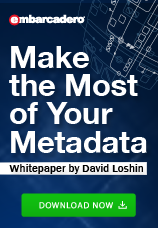In my last post, I suggested that the conventional “facet” approach to designing master data models (in which each master domain is modeled, designed, and implemented in isolation from the others in the enterprise) creates gaps in the ability to effectively build applications that facilitate successful execution of end-to-end business processes. For example, the perception (and consequently the definition) of the role of a “customer” changes between the marketing, sales, finance, fulfillment, and customer support stages of the product purchase process. Therefore the business process requirements for shared master data (say for “customer,” “product,” and “supplier”) may be different for the professionals supporting the different business functions.

As an alternative to the bottom-up approach to master model design (that is, with a focus on “customer,” then a focus on “product,” etc.), consider a top-down approach that not only looks at how each master entity concept is used at different phases of a business process, but also looks at the affinities among the different master concepts at each phase of the process.
For example, consider the simplified matrix in Table 1. Each row represents a master data concept and each column also represents a master data concept. For any stage of any business process, annotate the intersection between the row and the column if there is a step in the business process stage that involves touching both entities. In this table, which might look at the management of the corporate product catalog, there is a step in which we want to document which Supplier created, read, or updated aspects of a Product. This means that to support the management of the corporate product catalog, we will need access to both master Supplier and Product data at the same time.
|
|
Customer
|
Product
|
Supplier
|
Vendor
|
Credit Profile
|
Employee
|
|
Customer
|
|
Read
|
X
|
X
|
|
X
|
|
Product
|
|
|
|
|
|
X
|
|
Supplier
|
|
Create
Read Update |
|
|
|
X
|
|
Vendor
|
|
Create
Read Update |
|
|
Read
Update |
X
|
|
Credit Profile
|
|
|
|
|
|
X
|
|
Employee
|
Create
Read Update |
Create
Read Update |
|
Create
Read Update |
|
Table 1: Managing and using the product catalog
Here is an example process to collect the top-down master entity attribute data across a single cross-functional business process:
- Document the end-to-end business process model, including all data touch points and the type of touch (such as read, update, etc.).
- At each discrete process stage, identify the master entity concepts that are touched.
- Use a template (such as the example in Table 1) to document the affinities among the different master entity types.
- Engage the process owner to accumulate a list of the data elements for each of the master entities that are used during that stage of the process, and what are the usage characteristics (e.g. CRUD) at that stage.
At the end of the evaluation of the cross-functional business process, you have some visibility into what master data elements are shared across business functions. Applying this process for more than one end-to-end business function expands that visibility to show which data elements of which master entity types are most frequently created, read, updated, etc. Logically, the most frequently-touched data elements are your highest priority for master data modeling, and this informs the actual model design.
As a result of this business-oriented exercise, you have the information needed to devise a conceptual model. At this point you have identified those elements that will require enterprise alignment in terms of both structural and semantic metadata – data element name, data type, length/size, definition, usage scenarios, and presentation rules. As a byproduct of engagement with the business process owners, you also know who in the organization has a stake in aligning on the metadata and the master data model.
This must be supported by the right kinds of model and metadata management tools. The characteristics of the preferred set of tools include the abilities to enable you to capture business process flows, incrementally design master data models, provide a means for collaborative annotations from the community of stakeholders, and the ability to publish and share the model information to anyone in the organization who has an interest in using the master data management environment.
______________________________________________________________________________
You can also read this White Paper from David Loshin: Make the Most of Your Metadata
About the author:
 David Loshin, president of Knowledge Integrity, Inc. (www.knowledge-integrity.com), is a recognized thought leader and expert consultant in the areas of analytics, big data, data governance, data quality, master data management, and business intelligence. Along with consulting on numerous data management projects over the past 15 years, David is also a prolific author regarding business intelligence best practices, with numerous books and papers on data management, including the second edition of “Business Intelligence – The Savvy Manager’s Guide”.
David Loshin, president of Knowledge Integrity, Inc. (www.knowledge-integrity.com), is a recognized thought leader and expert consultant in the areas of analytics, big data, data governance, data quality, master data management, and business intelligence. Along with consulting on numerous data management projects over the past 15 years, David is also a prolific author regarding business intelligence best practices, with numerous books and papers on data management, including the second edition of “Business Intelligence – The Savvy Manager’s Guide”.